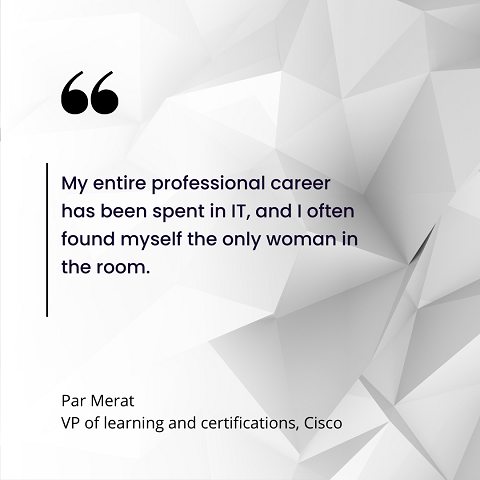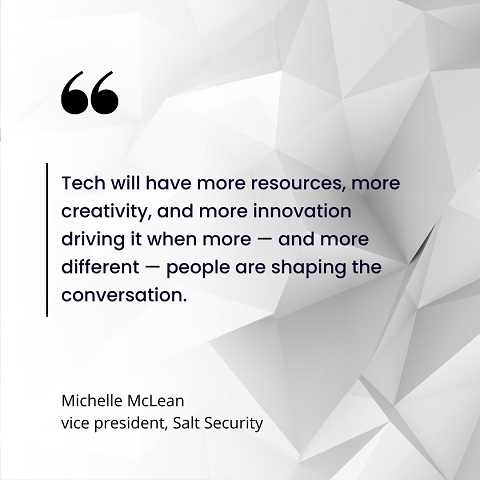Women in IT: Overcoming Adversity, Mentoring OthersWomen in IT: Overcoming Adversity, Mentoring Others
Despite progress, gender disparities persist in the IT industry. Here's why it's crucial to provide women with continuous growth opportunities in tech.
August 26, 2023

Women's Equality Day is celebrated each year on Aug. 26 to commemorate the 1920 certification of the 19th Amendment to the Constitution, granting women the right to vote.
While progress in women's equality has been made in the intervening century, a lack of female voices and leadership in the IT industry is indicative of the ongoing struggle women face.
Women have been working in IT just as long as men, yet they've faced significant roadblocks when it comes to equal pay and advancement opportunities — less than a quarter of women make up leadership positions.

Merat-Cisco
Addressing these issues creates a safe workplace experience for women and empowers them to feel like their workplace values their contributions.
Simply hiring a diverse group of people is not enough, however: Women must be continually given opportunities for career growth and advancement to keep up with the increasing pace of digital transformation.
Forging a Path for Other Women in IT
"My entire professional career has been spent in IT, and I often found myself the only woman in the room," said Par Merat, vice president of learning and certifications at Cisco.
She recalled that once, early in her Cisco career, she attended a strategic partnership meeting with a potential partner, and aside from herself, the room was filled with male executives.
In their attempt to make her "feel more comfortable," they brought several of their women administrators into the room, she said.
"I remember the entire experience felt inauthentic and uncomfortable all around," Merat said. "More than 20 years later, while women have more seats at the table, unfortunately, women are still a minority in the tech industry."
Related: A History of Trailblazing Women in STEM
Michelle McLean, vice president at Salt Security, noted that although study after study shows how a more diverse group can brainstorm a more diverse set of solutions, people's mindsets are understandably shaped by what they've seen.
"If they haven't seen women or people of color at the table, they don't recognize when they're missing," she said. "Tech will have more resources, more creativity, and more innovation driving it when more — and more different — people are shaping the conversation."
When these voices are absent, they must be consciously sought out; otherwise, people will simply "do it how it's always been done" and the organization will miss out on new insights, McLean said.
"Throughout my career, I have learned to convey my technical depth with confidence but without a chip on my shoulder," she said. "In any situation, my goal is to be heard, not to make a point, so we can all move forward. In my experience, showing how my knowledge can help the whole team make decisions, move fast, and get great results has been my most disarming tool."
Leadership Positions a Critical Beacon
From the perspective of Alicia Merlino, product engineer at Attio, it is critical to have women in leadership positions in tech — for several reasons.
"First, seeing women in tech leadership roles encourages other women to pursue careers in the tech industry," she explained. "Second, because of female leadership, a whole new breed of successful tech startups inspired by problems traditionally faced by women are emerging."
Related: Women in Tech Is More Than a Corporate Training Exercise
In one of her previous jobs, Merlino said the two directors of engineering were both women.
"Both of these women were strong advocates for diversity and inclusion in the tech sector and would look for opportunities to celebrate women in tech," she said.
For example, the team would attend different women in tech events, such as a Women of Silicon Roundabout, and would host companywide talks to discuss diversity topics and pushed to increase the parental leave policy from six to 12 weeks.
"In fact, during that period, the company reached 40% gender diversity in the engineering team," Merlino recalled. "Female candidates would often comment on how much they appreciated that during the interview cycle."
These types of efforts greatly benefit women during the hiring process, as they can feel reassured they will be respected in the workplace.
The Importance of Mentoring Women in IT
Mentorship plays into the idea of having advocates and allies for underrepresented minorities in tech.
"I've had two fantastic mentors who helped me learn new skills and advocate for myself," Merlino said. "One of these mentors was my engineering manager. She provided tailored feedback that felt specific to being a woman in tech."
For instance, she highlighted the common tendency for women to use softer language, which can be perceived as lacking confidence.
"My other mentor was a staff engineer," Merlino said. "He was able to look out for opportunities to help me learn, as he had a broad view of projects and initiatives going on in the company."
For example, he encouraged Merlino to lead a front-end training day and an investigation and discussion on how their team could implement GraphQL.
"The success of these projects was essential for my growth as an engineer and securing a promotion," Merlino said.
Related: ITPro Today's 2023 Salary Survey Report
Melissa Bischoping, director of endpoint security research at Tanium, points to her work with the Women's Society of Cyberjutsu and WiCyS, both nonprofits that empower women in cybersecurity by creating opportunities for mentorship, interview practice, skill-building workshops, and public speaking across multiple career levels.
"I have seen women from these organizations leverage these expansive networks to find new jobs, recruit talent, or identify growth opportunity," she said.
Bischoping calls herself an advocate for identifying and recruiting from non-traditional tech pipelines, noting that she herself took a "scenic route" into technology.
"My prior professional experiences in retail, medical transcription, sales, and customer service were all essential to the empathy and understanding I have for business problems today," she explained.

McLean-Salt
Nicole Sundin, chief product officer at Axio, said she has benefited greatly from mentorship throughout her career, and it's something she now extends to other women across a range of cybersecurity-related companies.
"Whether it's advising women on career success or modeling how to be a respected voice at the decision-making table, I strive to lead by example and help others navigate their particular challenges," she said.
Sundin added that a huge part of ensuring her voice and the voices of other women are heard is building relationships and trust, especially through one-on-one mentorship for women in the cybersecurity field.
"I embrace the responsibility of serving as a role model to the many women who aspire to contribute to the cybersecurity community," she said.
Whether they are in-line or working in a cyber-focused company, having one-on-one opportunities to talk with other women about challenges they are facing in a male-dominated field is part of growing the community, Sundin said.
"Whether driven by data, relationships, or both, if we share these learning with the broader community, we can inspire women to persevere and become leaders in tech," she said.
Recruiting from Non-traditional Pipelines
Bischoping has had "immense success"; however, she found it challenging to even break in the door as a single mother and career changer who completed college after many of her peers.
She implores organizations to recruit from community colleges and tech nonprofits that foster a community of research, practice, and skill-building to help close the talent gap.
"There are thousands of individuals like me from diverse non-traditional backgrounds who will be a force multiplier in your organization because of their drive and tenacity," she said.
Bischoping pointed to decades of studies demonstrating that more diverse teams yield stronger outcomes and increase innovation.
"This requires bringing women into the workforce across all levels and creating opportunities for women to see someone who looks like them at varying levels of leadership," she said.
By creating teams with greater diversity and actively removing employees who demonstrate bias or harassment, organizations can help spark a cultural change that grows more inclusive over time.
"This has a snowball effect of bringing the most diverse talent pool to your application portals, giving you the best chance of hiring innovators and leaders," Bischoping said.
About the Author
You May Also Like








.jpg?width=700&auto=webp&quality=80&disable=upscale)
